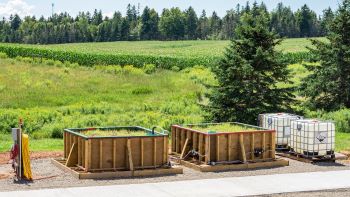For more information
Media Relations
Agriculture and Agri-Food Canada
1-866-345-7972
aafc.mediarelations-relationsmedias.aac@agr.gc.ca
Crop sprayers are essential tools for producers. They are used to apply liquid substances such as water, pesticides, herbicides and fertilizers to crops. Once the task of crop spraying is complete, the producer will clean the equipment by spraying it down. Traditionally, water contaminated from washing the crop spraying equipment (called pesticide rinsate), would run-off into the land. However, thanks to research by AAFC’s scientists, a more sustainable and eco-friendly solution is preventing pesticide residue from entering the environment.
Building on the successful groundwork laid by AAFC scientists in Prairie ecosystems, Dr. Erin Smith, a research scientist from the Kentville Research and Development Centre, has been collaborating with Dr. Tobias Laengle, a biologist with the Pest Management Centre based at the St. John’s Research and Development Centre. Together, they are working to investigate the use of on-farm biobeds and collect data on biobed systems in Nova Scotia and Newfoundland and Labrador.
First commercial on-farm biobed research project in Atlantic Canada
Most recently, Dr. Erin Smith has been working closely with a farm in Truro, Nova Scotia to construct the first commercial on-farm biobed site in Atlantic Canada. Construction of the Truro biobed site began two years ago and since then, Dr. Smith and her team have been working collaboratively with the farm to collect data. This farm provides custom spray services for local farms, therefore deals with large volumes of sprayer tank rinsate; making them the ideal farm to test the biobed technology.
The Truro, NS located biobed system consists of two large wooden pallet containers fed from a 100 foot concrete collection pad which collects all the rinsate from the farming spray equipment. The rinsate first runs onto the collection pad, then is gravity fed to a silt trap to filter out solids. Rinsate is then pumped through two separate biobeds linked in tandem. Both biobed units are lined and filled with a polyethylene liner, landscape fabric, a pea stone layer, as well as a uniform custom biomix (such as soil, peat moss/straw, and wood chips). The biomix allows the pesticides to be filtered out of solution and adsorbed. Microbial communities colonizing the biomix then feed on the substrate and help break down the contaminants. The system is connected to programmed timers that allow the flow to be adjusted depending on the volume and concentration of the rinsate to be treated.
Dr. Smith has been very pleased with the results that she is seeing so far. The filtration through the first biobed unit is achieving 85% to 87% removal of pesticides and up to 99% removal in the second biobed. She and her team will continue to explore how biobeds can be used in conditions in Atlantic Canada by fine tuning the flow requirements and management for long-term operation. By sampling the water rinsate and outflows, she will also be able to get an understanding of the long-term operational capabilities for various types of pesticides. This on-farm biobed will continue to be used as a demonstration site for producers to see first-hand how these systems work so they can learn how they can adopt them into their operations.
“I am very happy with the results we are seeing with the biobeds. With almost complete removal of the pesticides, these systems are proving to be an excellent tool to help prevent chemicals from entering the environment. I hope these positive results will encourage more producers to adopt these systems.”
- Dr. Erin Smith, research scientist, Agriculture and Agri-Food Canada
The biobed system can manage various types of pesticides making it a suitable technology for farmers across the country to adopt. Learn more about how AAFC biobeds are managing pesticide rinsate in several Research and Development Centres across Canada.
Photo gallery

A closer look at the two connected biobed units, their pumps and filters.
Related information
- Pesticide Risk Reduction at the Pest Management Centre
- Demonstration of pesticide rinsate biobeds to promote grower adoption in Canada
- Innovative biobed design prevents up to 70% of water contamination by pesticides on farms
- Kentville Research and Development Centre
- St. John's Research and Development Centre